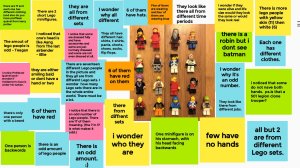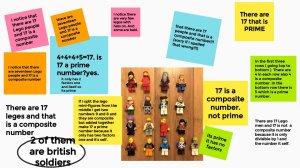How to Use the 5Es in Remote Math Instruction
A five-stage instructional model—engage, explore, explain, elaborate, and evaluate—can guide students to a deeper understanding of math.
Your content has been saved!
Go to My Saved Content.My math team has been experimenting this year with an instructional model called the 5Es, which was developed in 1987 by a team from Biological Sciences Curriculum Study (BSCS). The 5Es—engage, explore, explain, elaborate, and evaluate—parallel the pattern of problem-solving used by scientists and mathematicians to tackle real-life problems: They engage with the materials, explore possibilities through experimentation, explain and elaborate on their observations, and evaluate their new findings.
According to BSCS, educators can apply the 5Es at various levels of planning, including a yearlong program, a unit, or within lessons. One advantage of this approach is the opportunity students have for constructing their own understanding of a new concept through the engage and explore phases, rather than beginning learning with a teacher’s explanation.
Although it was developed for teaching science, the 5E instructional model is useful in math—teachers can design units that provide meaningful sense-making opportunities for their students.
My school division began the school year with remote learning in mostly asynchronous formats. In an attempt to increase both equity and collaboration across the division, grade-level teams were formed to share the work of planning between 11 elementary schools. All of the teams—not just the science teachers—were challenged to use the 5E format as we planned. What follows is an explanation of how we applied the 5Es to a two-week, fifth-grade math unit on prime and composite numbers.
Engage
In this phase, teachers provide a question, object, or situation that focuses students’ attention and helps them activate prior knowledge. In a math lesson, this might be a number talk related to a task students are about to tackle, or an opportunity to notice and wonder.

Our prime and composite unit began with an image of 17 Lego figures. We asked students to record on Google Jamboard what they noticed and wondered. All answers, both mathematical and non-mathematical, were accepted and encouraged at this point. Several students pointed out the odd number of figures because this was the topic of the previous week’s lessons.
Explore
Students really dig into a task in this phase. One goal of the explore phase is for students to have a shared experience that both they and teachers can draw on later when explaining a new concept or skill.
In a face-to-face math class, teachers would let go and allow students to explore a rich task with manipulatives or other models. When exploring prime and composite numbers, fifth graders typically are asked to create arrays with different numbers of objects. For remote learning, we tried to simulate this physical manipulation of objects with clipart that students could drag and drop on a Google Slides presentation.
Explain
It’s tempting to think that this is the part of the lesson or unit when the teacher explains the concept or skill. However, BSCS emphasizes that it’s actually the students who should explain what they observed or learned, while the teacher supports them with formal language as needed.
On the third day of our prime and composite unit, students used Flipgrid to explain what they had discovered while exploring an online divisibility tool. Flipgrid has proved to be an invaluable resource for students and teachers in this phase of the 5E instructional model. Teachers could then record video comments to clarify misconceptions and model precise mathematical language for students.
Elaborate
The elaborate phase gives students a chance to extend their thinking and transfer their developing knowledge to new situations. This is an opportunity for students to work out misconceptions, often through collaboration when in a face-to-face setting. During distance learning, our teachers have provided opportunities for collaboration synchronously through Zoom and asynchronously through Desmos.
Our division leaders encouraged teachers to use this phase of the unit to extend the learning for students who are ready for more of a challenge, and to provide support for students who haven’t grasped the concept yet. Our fifth-grade team developed a short formative assessment and assigned differentiated tasks through Google Classroom based on the results. Some students applied their new knowledge by labeling prime and composite numbers in a collection of interesting photos and in their own photos.
Others completed an Open Middle problem on Google Slides to integrate reasoning and problem-solving with their knowledge of prime and composite numbers. Fifth-grade teacher Mekenzie Schmitt—who is in her first year now—noticed, “Friday’s formative assessment seemed to be a good indication of where students needed to be. Participation in this differentiated activity was higher than usual. Almost all the students completed their assigned task, including the ‘already got it’ students who sometimes check out and the ‘not there yet’ students who sometimes freeze up.”
Evaluate
In the final phase, both students and teachers assess student learning. Formative assessment should, of course, happen throughout each phase, but summative assessment is incorporated here at the end of the unit.
One way our teachers prompted students to evaluate their own learning was to return to what they had noticed and wondered about the image of the Lego figures during the engage phase. We encouraged students to notice and wonder again, this time attempting to apply the new vocabulary they had learned.

Students left notes like the ones seen in the image above, which indicate varying levels of understanding at this point in the unit. The great thing about posing an open-ended question is that many more misconceptions are uncovered, compared to a basic question like, “Is 17 prime or composite?”
Next Steps
Educating in a pandemic is hard. Even with well-thought-out, student-centered plans that our team developed together, some students still struggled in the prime and composite unit.
I reflected with second-year teacher Kaitlin Bost about the use of our team-created lessons. She described students who didn’t log in to complete assignments, others who skipped straight to the task without reading any directions, and ones with a lack of experience or comfort with productive struggle.
But Bost is not giving up. She meets one-on-one with students via Zoom to walk through that productive struggle with them. She’s contemplating ways to edit assignments so that students don’t miss important directions, and she’s celebrating the successes that her students are having.
Whether you use the 5Es or another student-centered instructional model in your remote math instruction, couple high expectations for students with appropriate support, and celebrate students’ mathematical sense-making at every opportunity.
